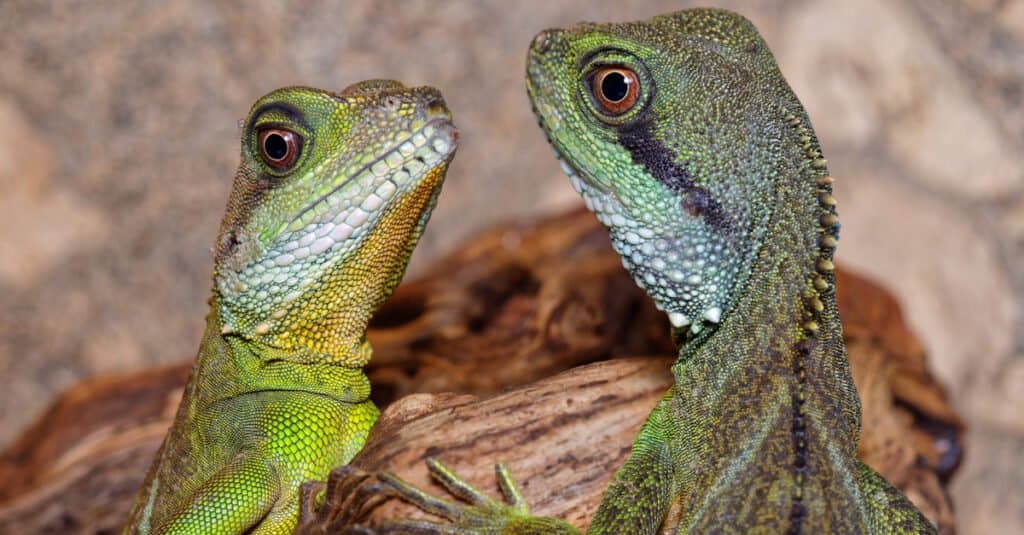If you’re in the market for an exotic pet, then perhaps consider getting a pet water dragon. Not only is it unusual, but it’s manageable. Here are a few things to keep in mind — as well as some products you’ll need to purchase — before you buy a pet water dragon.
Before Buying a Water Dragon
The water dragon, also known as the Chinese or Asian water dragon, is a type of large lizard that many people enjoy as an interesting and exotic pet (the Australian water dragon is a separate species and less commonly kept as a pet). It is characterized by green skin, a pale stomach, blue, purple, or orange throat, bulbous jaw, and a series of crests along the back. Originating from the tropical rainforests of China, Vietnam, Cambodia, and Thailand, they would be found along the banks of freshwater rivers and streams in the wild. These lizards can grow about 2 to 3 feet long, most of which is just the tail. The name comes from their love of water and ability to swim and hold their breaths for long periods of time.
In order for your water dragon to thrive, you will need to replicate its natural environmental conditions. The daytime temperature of the tank should be set to around 80 or 85 degrees Fahrenheit for the cool end and 95 to 100 degrees for the basking area. The nighttime temperature needs to be at least 75 degrees.
The size and quality of the tank is one of the most important aspects of its care, but that will be covered in more detail below. It is possible to house multiple water dragons together, but because males will fight each other, it might be a good idea to keep them completely separate. One male and a few females or multiple females together is usually ideal.
Water dragons are generally quite docile and mellow around people, especially if raised as a pet from an early age, but they are easily frightened and startled by loud noises or sudden movements. Wait until the dragon has become accustomed to your presence before starting to handle it on a regular basis.

How Much Does the Water Dragon Cost (To Buy & Own)
The water dragon costs about an average of $50. There are no unique color morphs for this species, so the price is pretty consistent. While this may not seem like much, you will need to pay hundreds of dollars for additional equipment. The ongoing annual cost for food is likely to be around $500 per lizard, plus a few hundred dollars for replacing old equipment and furnishings. Your pet water dragon should also receive an initial checkup at the vet and additional checkups every year after that. The price of medical bill can vary based on how hard it is to find a vet in your area who’s equipped to treat a lizard.
New Owner Shopping List: What to Buy
Before you’ve even brought your water dragon home, you should have the following items already purchased and ready to go.
- Tank – Owners should purchase a vertically-oriented tank that has plenty of room for climbing and a secure lid. A juvenile should get along fine in a 20-gallon tank, but as the lizard grows into adult, you will eventually need to upgrade this to a 60 or 70-gallon tank minimum. If you plan to house multiple water dragons together, then you will need a 150-gallon tank at least 6 feet in height. A temporary container to place your water dragon in is also recommended. Keep in mind that water dragons have a habit of rubbing their noses against the wall of the habitat. If you opt for a glass tank, then it is good idea to place some kind of paper or cardboard barrier along the walls to discourage this behavior.
- Substrate – Sphagnum, cypress mulch, and orchard bark all work well as a suitable substrate as long as the pieces aren’t small enough to be eaten and digested. If you are concerned that this could be a problem, then you should use a reptile carpet instead.
- Lighting – The habitat should be heated with an incandescent light or a ceramic heater during the day; a nocturnal bulb should be used at night. A separate UV bulb (or an all-in-one heater and UV light) should be used during the day to improve the lizard’s health.
- Thermometers and a humidity gauge – Two thermometers should be placed in the tank, one near the basking area and the other near the cooler area, to monitor and maintain the proper temperature. A humidity gauge will also help you maintain the correct environmental conditions.
- Décor – The tank should be filled with plenty of logs to hide under and branches or shelves to climb on. You might also want to consider using living plants such as hibiscus, ficus, dracaena, and spider plants.
- Water Dish and Food Bowl – The water dragon needs a suitably large water bowl in which it can swim and soak. Feel free to use waterfalls and air bubblers to increase the humidity of the habitat. A food bowl is a good idea to prevent the lizard from eating where it soils.
- Water Bottle – Misting the habitat at least once a day will improve the humidity levels of the tank.
Ongoing Needs: What You Need to Care for Your Water Dragon
Old equipment will need to be replaced from time to time as they wear down and become old. These items will need to be replaced on a fairly consistent basis. Fortunately, there are very few ongoing items you will need besides food.
- Lizard Food – The water dragon needs a constant source of food every day. They consume a wide variety of different foods items, so meals must be planned in advance. More about that will be said later.
- Substrate – Depending on which substrate you buy, it will need to be replaced on a regular basis, perhaps as often as once a week, as the old material becomes dirty and soiled. This is important to minimize the chances of developing infection and health problems.
- Lamps – As the bulbs burn out, they will need to be replaced every several months.
Exercise and Ongoing Care
Exercise can be done at the lizard’s own pace. As long as your habitat exceeds the minimum space required, your water dragon should have plenty of room to move around in. The climbing branch is absolutely essential to give your pet an opportunity to enjoy life as it might in its natural environment.
Tank cleaning is another important aspect of its ongoing care. In order to clean the habitat, you should place the water dragon in a separate temporary enclosure, scrub the inside with a reptile habitat cleaner or 3 percent bleach solution, and rinse it thoroughly with hot water. When the tank has finally dried, you can add in new substrate and anything else that needs to be replaced. The habitat should be cleaned about once a week.
Feeding Your Water Dragon
Your water dragon will need to eat a varied diet to stay healthy. Crickets, roaches, mealworms, earthworms, and other types of worms can be fed to your pet every day. Pinkie or fuzzy mice can be provided more intermittently; perhaps every two or three days for a juvenile and once or twice a week for adults. This should be combined with a helping of fruits and vegetables perhaps two to three times a week but adding up to no more than 10 to 15 percent of the total diet. Suitable choices include kale, romaine, squash, sweet potatoes, carrots, green beans, dandelion and mustard greens, strawberries, raspberries, mangoes, papayas, cantaloupes, and figs. Finally, it might be a good idea to provide daily calcium and vitamin D3 supplements to bolster your pet’s health.
It’s important to keep a few things in mind with the lizard’s diet. First, any rodents should be bought dead and frozen; live prey may fight back and do significant harm to your pet. The rodents will need to be thawed out slowly without using a microwave. Never prepare the food in your kitchen to prevent the spread of dangerous microbes. The second thing to keep in mind is that you should always place the food in a separate bowl or dish so the lizard doesn’t accidentally eat the substrate as well. Third, it might be a good idea to change up the diet on a regular basis to prevent the lizard from growing bored and finicky with its food. If the lizard has not eaten the food within 10 hours, it should be thrown out to prevent it from decomposing.
How Long Will Your Water Dragon Live
The water dragon is a long-term project. With proper care and good luck, it can live about 10 to 15 years in captivity. While some medical issues are impossible to prevent, proper nutrition and suitable housing will maximize the potential for a long, healthy lifespan.
Common Health Issues for the Water Dragon
You should observe your water dragon regularly for signs of health problems. A healthy water dragon will have a solid appetite, clear skin, and normal-looking feces. They will be active and alert throughout the day, climbing, jumping, and swimming around the habitat. An unhealthy water dragon, on the other hand, may be sluggish, lethargic, and unwilling to eat. It may have skin blemishes, sunken eyes, poor breathing, or discolored skin. Here is a list of the most common health problems associated with the water dragon:
- Stomatitis – Also known as mouth rot, this condition results from an infection of the mouth and gums. You may notice inflammation, blood, blisters, or pus that resembles cottage cheese. If it’s the result of a bacterial infection, then the vet can prescribe antibiotics to treat it.
- Respiratory disease – This condition can result from poor environmental conditions or an infection. Signs can include labored breathing, loss of appetite, and bubbles coming from the mouth or nose. If you are certain that the temperature or humidity of the habitat is not the source of the problem, then you may want to consult your vet.
- Gastrointestinal disease – Symptoms of a gastrointestinal disease may include poor digestion, loss of appetite, and bloody stool or abnormal feces. Some kind of infection or inflammation is likely to be the main culprit.
- Metabolic disease or vitamin deficiency – If the water dragon is unable to absorb enough nutrients, then it may lead to skeletal deformities, bone fractures, weakness, weight loss, and swollen limbs. Make sure it is receiving enough UV light and nutrients from its diet.
Where to Buy Your Water Dragon
The water dragon can be difficult to find in an ordinary pet store. You may need to look around a bit for a reputable exotic pet store or specialty breeder. It’s a good idea to find a seller who really cares about the quality of their animals. When it comes to the health of a pet, you should never compromise even if it means paying slightly more than normal. The water dragon can be brought home in a temporary container, but make sure the permanent habitat is all set up and ready to go.
Special Considerations with the Water Dragon
Like most reptiles, the water dragon will shed its skin at regular intervals throughout its lifetime. To help it along, you should make sure the temperature and humidity are set at the proper level. The water dragon may also require a sufficient amount of warm water to soak in. Younger dragons will shed about every to five weeks. Adult dragons, starting at around three years old, will shed every five to six weeks, and the rate at which it sheds may continue to decrease after five years old. The entire shedding process can take a few weeks to fully complete.
A healthy water dragon should be able to shed its skin with minimal problems. If your pet appears to be struggling, then it may be a sign of environmental problems or health issues. Either way, shedding is a particularly stressful time in any reptile’s life, and it may not appreciate being handled too much during this period. While you can help it shed the skin by soaking the dragon in water, you should not use force to tug the skin off its body. This could cause more harm than good. If problems persist, then you should contact your vet instead of handling it on your own.
Pet Water Dragon Guide: What You Need to Know FAQs (Frequently Asked Questions)
Are water dragons good pets for beginners?
Water dragons are considered to be an intermediate type of pet because of their finicky environmental needs. Beginners can still derive a lot of enjoyment from a pet water dragon, but you should be aware of exactly what you are getting into. Success is wholly a matter of preparation and effort. If you are not prepared to care for its needs, then it might not be a very enjoyable experience. The good news is that water dragons have fewer social needs than most pets.
Can a water dragon hurt you?
If they feel threatened or alarmed, then water dragons can bite out of self-defense. The wound may not cause too much damage but should be washed out thoroughly to prevent an infection. Fortunately, water dragons do not produce any venom or poison that can harm you.
What is the difference between an Australian water dragon and a Chinese water dragon?
The Australian water dragon is an entirely separate species from the Chinese water dragon. While they do share some similarities, they may require slightly different environmental conditions and diets than what has been mentioned here.
What are the key differences between the male and female water dragon?
The key difference between male and female water dragons are size, coloring, anatomical variations, and behavior.
Thank you for reading! Have some feedback for us? Contact the AZ Animals editorial team.




